I've shared a number of specifics related to early American freight wagons in previous articles as well as during presentations at special events. From giant freighters in Idaho and Colorado to those in California, the Dakotas, the Santa Fe Trail and all points east and west, these designs with their massive size, responsibilities, history, and lore are captivating. As intriguing as these huge workhorses can be, though, the very nature of the harsh terrain and loads they were subjected to have made them relatively scarce. It makes every encounter today a little more special and such was the case earlier this year.
This past June, I scheduled another trip to the West Coast with a plan to photograph and review several stagecoaches and western vehicles throughout central and southern California. With a full calendar at work, my time was somewhat limited. Nonetheless, I felt the planning left sufficient time to study the coaches and still squeeze in a few other family activities. Now, this is going to sound a little strange but, what's always surprising about these trips are the surprises themselves. I mean, no matter how much I travel, I'm amazed at what there is to discover - sometimes when we're not even looking for it.
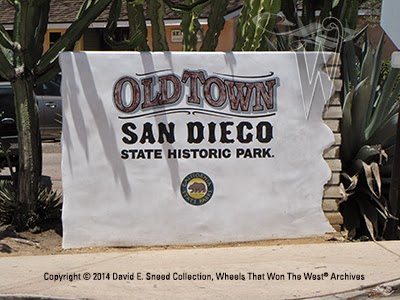 |
| The 'Old Town' park in San Diego offered an intriguing and family-friendly step back into American history. |
Landing in San Jose, we hit the ground running with visits to San Francisco, Stockton, Angels Camp, Wawona, Mariposa Grove, Anaheim, and Los Angeles. One ofthe last places we visited was Old Town San Diego State Historic Park. With the first human populations in the area dating back at least 9,000 years, the location is often billed as the birthplace of California. We arrived around 10:30 in the morning and were fortunate to find a parking spot close to the entrance. Inside, there are numerous shops, museums, restaurants, and curiosities to explore. The Wells Fargo building is near the entrance and houses a number of impressive exhibits. Among the historic highlights, the company has a Concord Coach as the centerpiece of the museum. This legendary set of wheels was originally built by the firm of Abbot-Downing in Concord, Massachusetts. It's coach number 251 and it was built in1867 for Wells Fargo. The coach is one of the famous thirty Concords photographed on flat cars as they were transported to Omaha, Nebraska in 1868.
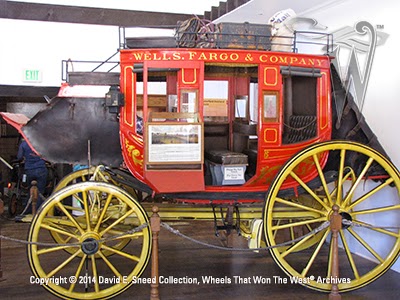
I wanted to record measurements and photos of this coach but I knew it would take a little time so we decided to first grab some lunch in the old Cosmopolitan Hotel. This building started as a single story adobe house in 1827 and, with additions, opened as a hotel in 1869. While we were waiting a few minutes for the restaurant to open, I noticed the blacksmith and carriage shop just a few yards up the street. Curiosity overtook me and walking in through the large outer door, I was surprised to see a number of period wagons and coaches on display. Most startling, was the lead and trail freight wagon. It was surprising because, in all my travels and discussions, I'd never heard anyone speak of a tall-sided freighter being located in Old Town San Diego. It was like I had found another long lost friend to compare and share with other surviving freighters.
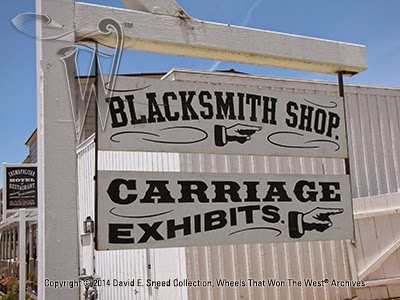
The exhibits in the Carriage & Blacksmith Shop at Old Town San Diego offer a look at several rare freighting and staging vehicles from days gone by.
The lead wagon stood 8.5 feet in height. It sat on 5 inch wide tires and 3 inch steel axles. Other dimensions included a heavy, 1-inch square circle iron, 60-inch wheel track, and 52-inch/44-inch wheel heights.
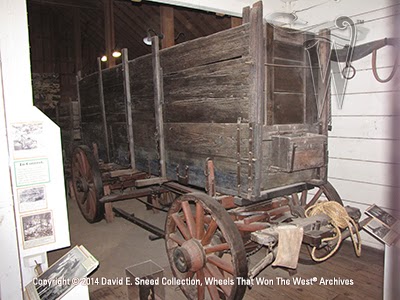
Old Town's lead freight wagon measures 16 feet in length with a 42-inch wide box.
The trail wagon was smaller, being just over 7 feet in height and an inch shy of 12 feet in length. Equipped with steel skeins and a flat trussbar beneath the axles, it was more of a heavy farm wagon. That said, it was not uncommon to see this type of arrangement in the late 1800s and early 1900s. While both wagons have had adaptations, there are still significant levels of originality present - especially with the lead wagon. In addition to the freighters, there are several original mud wagons, including a reproduction mud coach built by Doug Hansen of Hansen Wheel & Wagon Shop in Letcher, South Dakota.
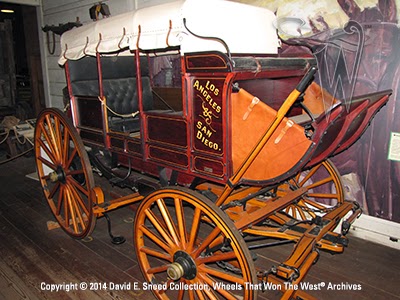
Doug Hansen and his team of craftsmen are well known for producing quality and correctly-styled western vehicles.
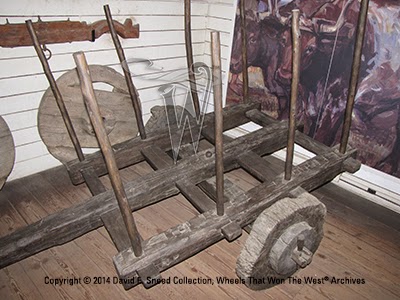
Dating to 1806, this extremely rare carreta is one of California's oldest surviving vehicles.
The collection also features a carreta or two-wheeled cart dating to 1806. Being over 200 years old, it's one of the earliest surviving vehicles in California. Finding these additional pieces was the icing on the cake for a trip that revealed literally dozens of other vehicles rarely shown or discussed. I'll spend some time in future blogs sharing more details on a variety of vehicles we explored during this trip. As is almost always the case, the only shortcoming in the venture was the lack of time I had to explore the other intriguing wheels in the area. Someday I hope to get to the Banning and Autry Museums as well as other local collections.
In the meantime, if you find yourself in California, don't miss any of the numerous opportunities to get up close to some of the most impressive survivors of America's early western heritage. Beyond their individual provenance, each holds clues to further interpret, identify, and preserve some of the most dramatic wheeled history in the continental U.S.